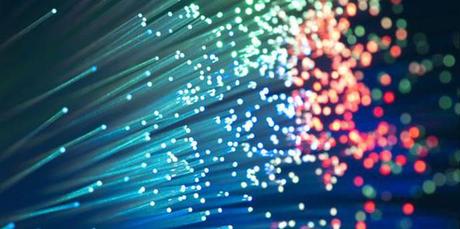
Internet service providers allow customers to connect to the World Wide Web. Each ISP can do so at different data rates and with a different latency, which are two things decided by the type of infrastructure that physically connects you to the Internet.
Dial-up, DSL, satellite and even 3G Internet all offer the same basic ability to connect to the Internet. The difference is that fiber optic Internet is able to do so with some of the highest throughput values and some of the lowest delay.
The single question most people have is the following: how do ISPs manage to deliver such amazing, top-notch speeds that allow customers to load web pages nearly instantly, send large attachments and download enormous files without interruption all while delivering the same kind of reliable speed?
The answer to that question lies in the one thing that makes fiber optics different from all the other types of Internet connections out there. It makes use of the fastest known naturally occurring thing in the universe: light.
Light travels at an amazing 670,616,629 miles per hour. That means light travels faster than you could even think of blinking.
The speed of light is considered a universal constant. It is, according to the current laws of physics, the fastest thing in the universe. There is nothing faster than it, which means everything else is slower.
If light is the fastest thing in the universe, does that mean we’ve reached our Internet speed peak? The short answer is that we haven’t even come close to it.
The most relied upon method of signal transmission is through the use of copper wire that has already be laid out for telecommunications. This includes copper wire used for phones, DSL and cable connections. A majority of this copper wiring is heavily shielded coaxial cable, which has a maximum “speed” of transmission that is only 66% the speed of light.
Logically, you can reason that this is slower because it is essentially any other type of wired Internet with another step added. It not only has to travel through wires, but it also has to travel sluggishly through the air and then back down to Earth again. This is why the delay times on a satellite connection are usually higher than that of any other type of wired connection.
This “added step” theory is true even when the connection uses something like an optical link. While light is the fastest thing in the universe, an added step almost always means an added delay.
While fiber optic Internet technology may be the best type of speed available to Internet customers, it is by no means perfect. Few companies have put up the necessary infrastructure needed to make their entire local network out of optical connections. This leaves a large ‘gap’ that is filled by those slower, sluggish copper connections.
Fiber optic technology can also have the capacity of data it can carry increased as new methods of sending data such as wavelength multiplexing becomes available. This would theoretically allow multiple channels of data to be sent and received instead of an on or off bit, similarly to how phones multiplex signals over each other to increase voice transmission quality.
According to Internetserviceproviders.com, current fiber optic technology can allow for mere milliseconds of latency and more efficient bandwidth because is uses light instead of relying on electromagnetic forces like copper cable infrastructure does. As older copper cable infrastructure is replaced by fiber optic cable, you may even continue to see latency decrease and speeds increase. The Internet speed “peak” is so a long way away from being obtained.
Skylar Michelle James is a woman who loves technology. Currently Skylar is a graduate student in the Boston Massachusetts area. She is writing her thesis on the Internet Philosophy. Much of her focus is on the future of internet and how to prepare. When she is not studying, she is freelance writing to keep her in the technology loop. She also does research for internet websites. Please connect with her via twitter @SkyJamesWriter.
1 Flares Twitter 1 "> Facebook 0 Google+ 0 "> LinkedIn 0 "> StumbleUpon 0 "> Filament.io Made with Flare More Info"> 1 Flares ×
- Bio
- Latest Posts

Guest
Guest posts from various insightful people and companies. Want to feature on TechDrink? Get in touch.

Latest posts by Guest (see all)
- Fiber Optic Technology : Have we reach our Internet Speed Peak? - July 29, 2013
- What Does 24/7 Internet Access Mean for How We Live? - July 26, 2013
- Best Apps and Online Sites to Save You Money - July 8, 2013

